Home Tweet Home
By Kelli Anderson
Appears in the October 2022 issue.
One evening on their back porch, Paula and David Altekruse of St. Charles noticed something wasn’t right. “It was just silent,” David recalled. “Where were the birds?” Over the past 50 years Illinois has lost 80 percent of some species, according to the Prairie Research Institute at the University of Illinois. However, creating bird-friendly landscapes, as the Alterkruses have learned to do, is helping some birds—like the red-headed woodpecker—recover.
As the mercury begins to drop, fall is the most critical time to provide shelter, food, and water—essential lifesaving support for overwintering and migrating birds. Planting native shrubs, trees, and low-lying plants provides the widest range of protection from the elements and predators while supplying specific insects, berries, and seeds birds have evolved to eat.
But smaller steps help too. Here are some tips to help you wing it.
Food
Protein and fat are critical. “Bird metabolism is higher than ours and they go through energy quickly to stay warm,” says Angelique Harshman, manager of the Knoch Knolls Nature Center in Naperville. Other feeding
tips include:
• Keep feeders full daily; birds come to depend on them for winter survival.
• Stock nutritious foods like black oil sunflower seeds, suet, and unsalted peanuts (a blue jay favorite).
• Leave leaf litter on garden beds to provide protein-rich insects and larvae.
Water
Winter becomes a water desert for birds during cold snaps and storms. “We have a heated bird bath we put out,” says John Sprovieri, president of the Kane County Audubon Society. “Or you can get a simple heating device.” Bonus: More birds flock to yards with food and water than those with feed alone. To optimize:
• Place water near food sources.
• Don’t let water freeze; birds expend precious energy searching for alternative sources.
• Keep water vessels clean.
Shelter
Birdhouses certainly protect birds from winter elements, but ultimately Mother Nature knows best. “Native trees are the best natives of all,” says Jon Duerr, former executive director of the Kane County Forest Preserve District, about the ideal bird shelter. Some things you can do:
• Reduce lawns and increase sheltering plantings.
• Plant berry-producing shrubs for double-duty food and shelter sources.
• Add evergreens as protective cover year-round.
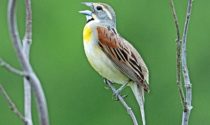
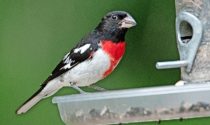
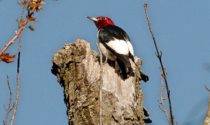
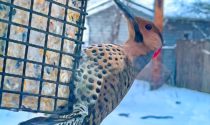
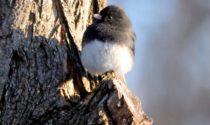
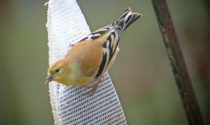
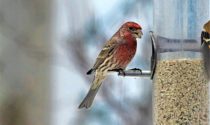
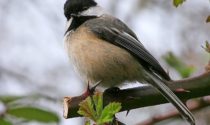
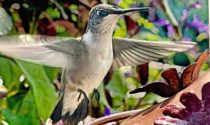
Ruby-throated hummingbird
Backyard Bird BINGO
Feathered friends you’re likely to spot in the western suburbs
Photos courtesy of Bob Andrini/Illinois Audubon Society (Chickadee, finch, Goldfinch, and Junco), John Sprovieri/Kane County Audubon Society (Woodpecker, Dickcissel, and Grosbeak), foxburrow media (Flicker and hummingbird), and Getty images (Indigo Bunting)


